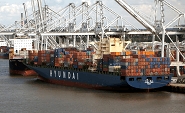Shipping and Logistics

Surge in Imports Fills Port Warehouses
Written by Sandy Williams
August 20, 2020
Ports on the West and East coasts were overwhelmed by a surge of imports in July and the trend is expected to continue into September. The Ports of Los Angeles and Long Beach report congestion and full warehouses due to a 40 percent increase in Asian imports from May to July. Chassis shortages are common in the West and at a premium at the Port of New York and New Jersey.
Val Noel, chief operations officer at TRAC Intermodal, told JOC.com that the 4,000 chassis (trailers used to transport ocean containers over the road) available three week ago has dwindled to 400.
“In three weeks’ time, the trade has eaten through 3,600 chassis. That’s almost unheard of,” said Noel. “Everybody can get a chassis, but it takes a little bit longer than we would like. New York and New Jersey remain fluid, everything is going, but there may be a little delay.”
In California, container and chassis dwell times at warehouses is becoming a critical problem, said Nathaniel Seeds, COO at FlexiVan.
“If before it took one to two days [to turn the equipment] and now it takes three, four, five days, that’s a problem,” Seeds told JOC.com. He added that the surge in cargo is overwhelming warehouses, requiring that truckers deliver containers to intermediary drop-off yards.
During the first half of 2020, blank (canceled) sailings led to a drop in volumes at U.S ports. With blank sailings on the decrease in June, import volumes are ballooning.
Domestic freight is also on the increase, said Steve Schulein, vice president of New Jersey-based logistics provider National Retail Systems. With his international container business almost doubled, he is seeing domestic freight volume “really going through the roof.” The increased workload is complicated by a shortage of seasonal workers. Warehouses report that competition for workers has increased due to the extra $600 unemployment benefit to laid off workers.
“If you combine that with the international freight, that means we have to work more shifts in a week. That requires more labor, and it’s creating a little bit of pressure,” Schuelein said.

Sandy Williams
Read more from Sandy WilliamsLatest in Shipping and Logistics

US Great Lakes iron ore cargoes down notably through May
The Lake Carriers' Association reported a considerable decline in monthly iron ore shipments from US ports on the Great Lakes.

Wittbecker: West Coast port congestion
What's going on in West Coast ports?

Wittbecker: Mexico invests in port capacity despite US tariff troubles
The Mexican government aims to transform Manzanillo into the largest seaport in Latin America, capable of processing some 10 million TEU (20-foot equivalent units) per year by 2030. It is already Mexico's largest port and the third largest in Latin America, handling nearly 4 million 20-foot containers in 2024.

Wittbecker on Aluminum: When do the tariffs reach Main Street?
Containers sailing from China in April are down 15%-20% and Hapag Lloyd says their future bookings transpacific are down 30%.

Wittbecker on Aluminum: US-China trade war clobbers cross-Pacific trade
Container shipping lines have sharply increased blank sailings on Transpacific routes in response to escalating trade tensions between the US and China.
